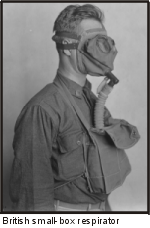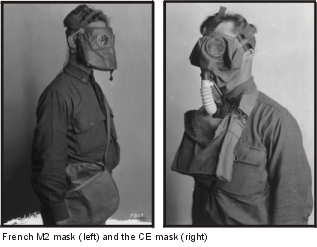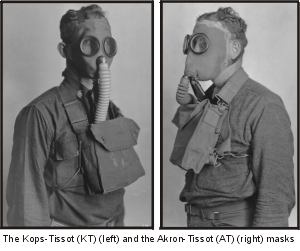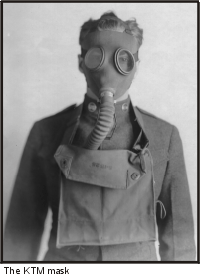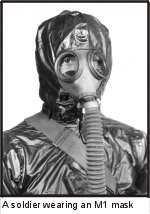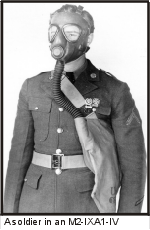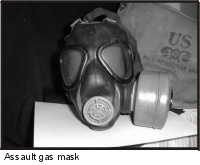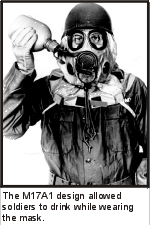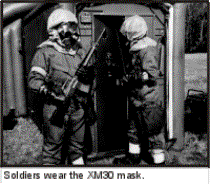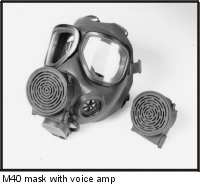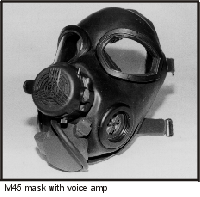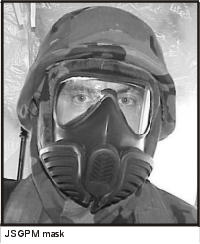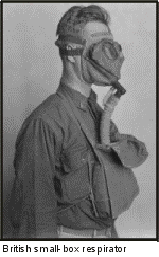
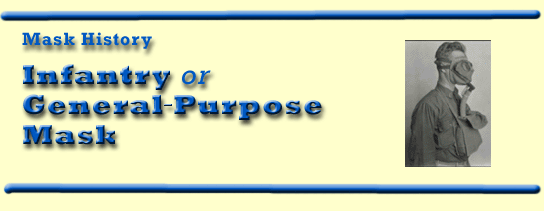
By Major Robert D. Walk The perfect infantry mask is nonrestrictive, easy to
breathe through, comfortable, and fully compatible with all military
equipment, from sophisticated optical-sighting systems to common-soldier
equipment such as helmets and canteens. Over the years, millions of
dollars have been spent on research in various attempts to find the
prefect mask. In the process, the United States has produced a myriad of
masks—from the uncomfortable but effective masks of the First World
War to the easy-to-wear masks of today. Each mask produced exemplified
the technology of its day. World War I When the United States entered the First World War, the
French M2 mask and the British small-box respirator (SBR) were the only
two masks readily available. Not knowing which was better, the American
Expeditionary Force (AEF) bought both and issued them to our doughboys.
The French M2 mask used multi-layered, impregnated
cheesecloth to filter out the chemical agents. It had no outlet valve
and was difficult to fit properly. It did not provide adequate
protection against chloropicrin, so it was not the primary mask for the
soldier. It, however, was readily available since the French
manufactured more than 50 million during the war. While it was more
comfortable to wear, it was not as effective as the SBR. During gas
attacks, soldiers would initially wear the SBR but then would change to
the M2 for its comfort and get gassed during the changeover. This was
not acceptable, so the M2 was removed from service as a secondary mask.
Not satisfied with Europe’s available masks, MAJ Karl Connell of the
AEF Gas Service developed the Connell mask for the infantry in Europe. The Connell mask was a stamped-brass mask with small
eye lenses and a sponge rubber seal for the face. Official histories
called this a single-line-of-defense mask; the single line of defense
was the face seal. As the soldier inhaled, the air was drawn over the
eye lenses to keep them clear. Unlike all other American masks in World
War I, the filter canister was suspended behind the head. Up to 1,000
copies of the mask were possibly produced in Great Britain and sent to
the United States for evaluation. This mask was not as comfortable as
the later American Tissot masks, so in July 1918, production was
discontinued. Some of the design features, however, influenced some
future mask designs. (Look at the Navy masks of World War II and you can
see the lineage!) In addition, the six-point head harness was used on
later mask designs. The U.S. Bureau of Mines initiated work for a good
protective mask. Copies of the SBR and the French M2 were examined, but
the first mask manufactured was sight-unseen imitation of the SBR. This
SBR, while a tremendous effort, was not good enough to use in war.
Unfortunately, 25,000 were manufactured before the flaw was discovered.
These masks were used for training and could be identified by the large
black-filter canister. While not bad for a first effort, an actual SBR
was brought from Britain for the United States to examine and copy.
The next version was the Richardson, Flory, and Kops
(RFK) mask (named after its designers—Ralph Richardson, E.L. Flory,
and Waldemar Kops), of which more than 3 million were produced before
the war ended. On 11 November 1918, about 40,000 masks were being
produced daily. This mask provided a DOUBLE line of defense—mouth tube
and noseclip and face seal. It included improvements in the head
harness, angle tube (inlet and outlet for the mask), and facepiece
construction of the CE. Unfortunately, it still retained the SBR’s
weak points—the mouth tube and noseclip, which added the second layer
of protection and also added discomfort. This discomfort caused the
soldiers to try and adjust or change the mask, causing casualties.
Checking around, we found an answer from the French—the Tissot mask.
The AT mask, developed in parallel with the KT,
integrated the deflector of the Tissot with the angle-tube
arrangement—the inlet and outlet for the mask was in one—of the RFK.
As with the KT, speech transmission was not impossible but it was
difficult. This mask, while good, did not fully protect soldiers with
high cheekbones or hollow cheeks. However, it was still an improvement
and was produced in quantity (297,000 manufactured before the
armistice). Using the best features of all masks, the Kops-Tissot-Monroe
(KTM) mask was adopted.
A molded mask, developed in parallel to the KTM, was in
advanced development as the war ended but was never completed and put
into production. This was the "Victory Mask" developed at the
Long Island Laboratory of the Gas Defense Service. This mask was
designed as a one-piece mold and then assembled, eliminating the
vulnerable seams present in the previous masks. Unfortunately, work on
the Victory Mask was abandoned after Armistice Day (11 November 1918),
and the KTM was adopted as the standard Army mask after the war and
soldiered on. The next molded mask did not appear for 20 years. Between the Wars Initially called the KTM, it was also known as the
Model 1919 and later the MI mask. The mask was produced in five sizes to
fit the majority of soldiers’ foreheads (masks were marked number
1—the largest, to 5—the smallest). The carrier went from the chest
(M1919 carrier) to the side (MI carrier). This mask solved the comfort
and breathing problems as best it could, but communications, while
better, were not solved. During this time period, the filters effectiveness
continued to improve. With filter changes, carriers changed. Since there
was little money to replace all filters and carriers to one standard
design, the Chemical Warfare Service (CWS) developed a nomenclature to
identify the masks. Each mask was identified by the facepiece model,
filter model, and carrier model separated by dashes. Thus, an MI
facepiece with an MIV filter canister and an MIII carrier was an
MI-IV-III service mask. In 1934, improvements to the mask were adopted as the
MIAI. The mask was now repairable because of the screwed-in eye lenses,
and it fitted better. When researchers developed a mask that fitted 90
percent of the soldiers, sizes 2, 3, and 4 were replaced by the
universal size (facepieces marked with a U), and the MIA2 was adopted in
1935. The MIAI soldiered on in sizes 1 and 5. Upon mobilization of
American industry in 1940, the MIA2-IXA1-IVA1was the first mask produced
in quantity for World War II. In 1944, when sufficient newer masks were
on hand, the MI-series mask was declared obsolete.
Budgets were constrained in the interwar years. To
reduce the cost of chemical training, the chemical branch developed a
training mask. This mask was molded rubber and took less effort to
manufacture than the service mask. It also was more comfortable. The MI
(1940) was produced with an MIV outlet valve, and the MIAI (1941) was
produced with an MV outlet valve. It used the MI training filter and was
carried in the MI training gas-mask carrier. The original was thus the
MI-I-I training gas mask. Because of the obvious improvements over the
MI-series service gas mask, the MI training facepiece was assembled with
service gas-mask components and adopted as the M2-IXA1-IVA1 service gas
mask. The MI training mask, renamed the M2 training mask to reduce
confusion (yet causing some), was used by soldiers in combat zones
because of its small size and easy storability. This mask was used by
the Airborne forces and by the jungle fighters in the Pacific. Because
of the harsh conditions of the Pacific, the CWS created a waterproofing
system for the mask. World War II
The M3 lightweight-service mask was the next attempt at
a perfect mask. This mask resulted from experiments on various filter
designs and carry locations. It used a shorter hose (18 inches) and
smaller filter canister (M10) than previous masks. The M10-filter
canister was smaller and lighter than the MIXA1, provided almost the
same protection, and used the M8 outlet valve. The M6 carrier held the
mask, three protective covers, and one tube of protective ointment.
Adopted in 1942, it was known as the M3-10-6 and weighed about 3 ½
pounds. The M3 was the first American mask to use a nose cup. The M8s,
along with other early outlet valves, were fouled easily with mud, so a
new outlet valve was designed—the C15. The basic C15 design was so
good that it is still used today. The C15 outlet valve used the M3A1
facepiece. No original M3A1s were produced; all were converted from M3s.
In World War II, 4,069,556 M3 masks were procured. Improvements to the
M10 canister resulted in the M10A1 canister, still in use in the year
2000. In 1949, all masks using the M10 canister were declared obsolete.
The M3-10A1-6, using the improved M10A1 canister, was not declared
obsolete until 1961. Initially, production of the mask was slow because
of tooling difficulties and the learning curve on using neoprene for the
facepiece instead of rubber. When the demand for M3s exceeded its production
capabilities, a stopgap solution was found. The M2-service gas masks
could be modified and rebuilt to the same standard, creating the
M4-series lightweight gas mask. This was adopted in 1942 but not
produced in quantity until 1944. The hose for the M2-series mask was 27
inches long, and the hose for the M3-series mask was 18 inches long. By
cutting off 9 inches of the M2 hose and vulcanizing it to another 9-inch
hose piece, three M3 hoses could be produced for every two M2 hoses. As
with the M3, the M4 used an M8 outlet valve and the M4A1 used the C15
outlet valve. In World War II, 3,672,069 M4 masks were procured. As with
the M3A1, all M4A1s were produced by retrofitting M4s with the C15
outlet valve. The masks were declared obsolete at the same time as their
related M3 masks. The soldiers now had a lighter mask but still did not
have adequate speech transmission and light enough weight. The Army
ground forces wanted something better. This led to continuing research
in mask design. During World War II, research on producing the perfect
mask continued at a record pace. New concepts were tried and discarded
or adopted. With a critical shortage of rubber in the United States
because of the loss of the major rubber-producing countries in Asia
(Malaysia and the Dutch East Indies [later Indonesia]), a substitute
rubber had to be found. Research resulted in the use of neoprene, which
was used in mask components during the war. In the search for a better
mask design, the British lightweight-mask concept of a filter mounted on
the cheek was used on the E6 mask designed by the Massachusetts
Institute of Technology.
The Massachusetts Institute of Technology engineers
looked into quick modifications of existing masks to fill the void.
Modifications to the M2A2 service and training facepiece examined
included attaching an M11 filter to the mask horizontally, vertically,
and at a 45-degree angle. A shortened M10A1 filter directly attached to
the M3 service facepiece (similar to the M2 training gas mask) was also
examined. After field tests with troops, which included checking the
mask for ease of storage; water leakage in the rain; and comfort in the
standing, kneeling, and prone positions, the 45-degree-angled filter
attachment was deemed best and adopted as the M8 snout-type gas mask.
The standard M2A2 facepiece could be modified quickly with a new head
strap and filter-attachment insert and issued. It was carried in the M10
carrier, a modified MI training gas-mask carrier. During the war, 1
million masks were authorized and more than 300,000 modified. The use of
the natural rubber M2A2 facepiece (which became the M8 snout-type
facepiece with the inclusion of the head strap and filter mount) kept
this mask in use for more than 10 years. By mounting the filter under
the chin, this mask could use the early steel-cased M11 canisters (later
M11s were aluminum). The steel canisters were not usable on most other
masks (M5 and M9) because of the weight imbalance caused by the filter.
The entire nomenclature of this mask was the M8-11-10 mask. In 1958 it
was declared obsolete. After the initially successful introduction of the M5
mask, work continued on improving the design of the mask for better air
distribution. The combat experience in Europe during the winter of 1944
disclosed a major problem (cold set) in the mask with neoprene, which
was used in the construction of the M5 facepiece. Cold set caused the
mask to get rigid in cold weather, rendering it incapable of forming a
good seal on soldiers’ faces. The result was the E48. Instead of
passing the air under the chin as in the M5 mask (causing most of the
air to come in on the left side), the air flowed across and in front of
the nose, pro-viding better air distribution (and giving it a big-nosed
look). This protrusion led to it being a "mustache-type" mask
in some publications. The E48 also was made of butyl rubber, a rubber
that did not get cold set. This mask was deemed fit for use and adopted
as the M9 service gas mask in 1947.
The 1950s In the 1950s, with a plethora of masks still standard
(M2-series, M3-series, M4-series, M8, and M9), the Chemical Corps
initiated research on a replacement mask. The program’s goal was to
develop a lightweight, comfortable mask for the soldier that occupied
less space and weighed less than its predecessors. In the search for a better mask, several variants were
tried. One was a modified M9 mask, another was an entirely new mask
without a conventional filter, another was to be attached to the helmet
so that it could be donned rapidly, and another was a hood-type that
sealed at the neck. There was even thought of developing an inexpensive,
disposable mask to issue to soldiers until the need for the full-sized
mask was realized. The unconventional filter mask showed promise and was
further developed into two models—the E12 for rapid donning and the
E13 with detachable filters. These masks were developed further; the E13
being seen as the most acceptable model. In 1959, with minor changes,
the tenth revision (E13R10) was adopted as the M17. The 1960s
What to do? Soldiers in the field needed protection
against the riot-control agents in use and desired a lightweight, easily
carried protective mask (or none at all). This requirement led to the
development of the XM27- and the XM28-series masks. Each used a
high-efficiency-particulate air filter to remove the riot-control agents
but provided no protection at all against military-standard chemical
agents. The XM27 mask was effectively a green silicone M17, while the
XM28 was a totally new design. Experience in field use in Vietnam showed
the XM28 to be superior in design, comfort, and storage; so, after four
revisions, the XM28E4 was adopted as the mask, riot-control agent M28 in
1968. Many people refer to this mask as the "grasshopper"
mask. The M28 was widely procured (up to a million examples) and
surplused to many police departments after the war. In 1976, the M28 was
declared obsolete. The 1970s The 1970s focused on the logisticians and money
concerns. After Vietnam, the Army had four standard masks—M17 (and
A1), M25 (and A1), M24, and the M9A1. Two (M25-series and M24) were very
similar and only had a few dissimilar parts. The others were unique with
few interchangeable parts; therefore, maintaining spares and parts for
these masks was expensive. The XM29 program was developed to make a
common-mask system, simplify logistics, and save money. This one mask
would use a common facepiece for all variations and would be of
one-piece, injection-molded, transparent, silicone rubber. Silicone, the
wonder material of the aviation industry in the 1970s, doesn’t suffer
from cold set, is nonallergenic, and seals to the face in a wide range
of temperatures. To improve sealing, the facepiece used an in-turned
periphery. The mask used a screw-mounted NATO-standard filter canister
that mounted on either cheek (right or left side). The screw mount not
used by the filter had an insert that functioned as a voicemitter. In
the front, the mask had a front voicemitter and drinking tube. Unlike
the M17 mask, filter changes were rapid, and the mask could be used with
two filters mounted to reduce breathing resistance. Unfortunately, the
XM29 eye lens had a tendency to "frost," but this could be
corrected by scrubbing it with a mild cleanser. However, the silicone
required special coatings to provide the necessary protection against CB
agents or decontamination chemicals. The technology did not exist yet to
coat the silicone and allow it to remain transparent. Lens-coating
problems caused the Army to develop the XM30 series, which was
effectively an XM29 with a separate glued-on lens. The 1980s
With M17-series masks generally more than 10 years old
and used hard, the Army reopened the M17 production line in 1983. The
M17 produced an M17A1 without the resuscitation-tube capability and was
designated the M17A2. This mask also was produced in a size XS—the
first in a U.S. mask. The XS mask facepiece used the in-turned periphery
to improve the fit on hard-to-fit soldiers (and to cause untold grief to
these soldiers when they tried to change the filters!). After years of
service, the resuscitation tube was deemed useless and discarded. The
M17A2 still only had one voicemitter and, in the 1990s, a separate
loudspeaker by Audiopack was authorized to improve communications with a
large group. While producing the M17A2, the Army initiated a
minimum-change, minimum-risk program for the M40 series.
The 1990s
While the M40 and M45 are excellent masks, the Army
needed to do better. The perfect mask still did not exist. The RESPO-21
project was begun as a technological leap forward in mask-protection
technology and, in 1996, evolved into the Joint-Service General-Purpose
Mask (JSGPM) program. The JSGPM is known as the XM50. As initially
demonstrated, a technology demonstrator proved to be lightweight and
compact. Protection from a variety of chemical agents and
toxic-industrial materials is planned. Comfortable to wear with minimal
peripheral vision loss and low breathing resistance, this will be a
Cadillac (maybe even a Rolls Royce, considering the maker) among masks.
As all services have signed on to the program, this mask will replace
all M40-series, M42-series, M45 (nonaviation applications) and MCU-2/P
masks. This will drop the cost of masks and spare parts by an economy of
scale. This will meet the program's goal of lower total cost through low
initial investment and low operating cost. Sustainment is being considered throughout the design
and testing phases of the program. Through the use of new, revolutionary
manufacturing methods and techniques, the military hopes to procure a
proper mask that meets the requirements but will have a low enough
initial unit-issue cost to consider alternative sustainment concepts.
When grossly contaminated, or at the end of its service life, the mask
would be thrown away properly. The soldier, marine, or airman would then
be issued a replacement mask. The idea is to consider and simplify
logistics.
The XM50 is a technological leap forward, but it still
has a long way to go. As of September 2000, the first prototypes were
received from the government’s prime contractor—Avon— which won
the benchmark "cradle-to-grave" developmental, production, and
sustainment contract. The XM50 program can only succeed with the
continued dedication of an extensive joint-service, integrated-product
team. You can contact the system manager for the JSGPM at his Web site
(SBCCOMs). He wants to develop the best mask for the soldiers, so he
will review all ideas submitted. Conclusion The search for the best protection for our soldiers
continues. Choosing the mask that performs best while logistically
supportable is difficult. During the years, the Army has examined and
procured masks to protect soldiers while continuing the search for the
best mask. The current standard mask, the M40A1, has an excellent
protection factor. Meanwhile, there is an ongoing search for a better
mask in the JSGPM program. References Major Robert Walk is an Active Reserve chemical officer
presently assigned to Headquarters, United States Army Reserve Command.
He is a volunteer hazardous-materials technician and firefighter for
Fayette County, Georgia.
|
